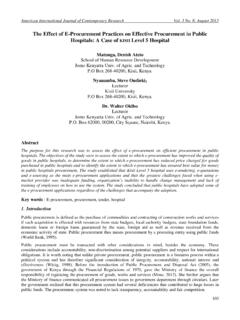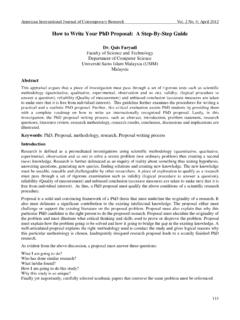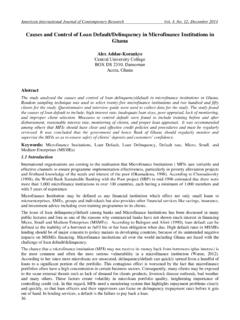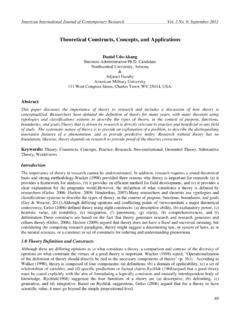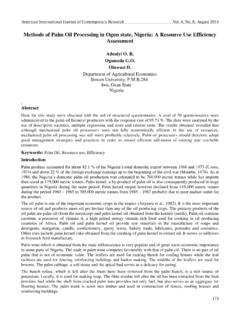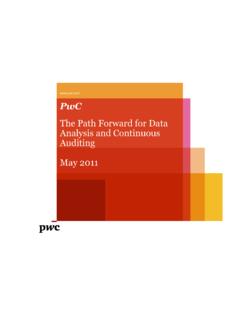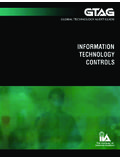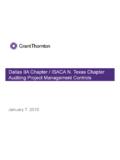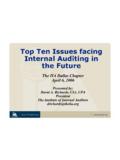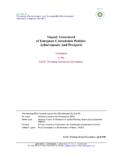Transcription of Measuring the Internal Audit Performance: Tips for ...
1 American International Journal of Contemporary Research Vol. 3 No. 4; April 2013 71 Measuring the Internal Audit performance : tips for Succesful Implementation in Turkey Tamer Aksoy Associate Prof., PhD. CFE, CPA, CRMA, CAE, TOBB University of Economics and Technology Business Administration Dept. Ankara Turkey. Sezer Kahyaoglu CPA, CIA, CFE, CFSA, CRMA, Partner, Grant Thornton Advisory Services Izmir, Turkey. Abstract As a capable emerging country and a candidate for EU accession, Turkey needs both structural transformation and an ongoing development and harmonization of its capital market legislation. For this reason, corporate governance framework and the modern Internal auditing practices could enable Turkey not only to control its own risks superior but also to enhance the market's confidence in its commitment to sound fiscal and monetary policies.
2 In this paper, we evaluate the Internal auditing performance metrics considering the Institute of Internal Auditors (IIA) standards to make relevant recommendations for practitioners in Turkey. In this way, we aim to increase the awareness on the importance of corporate governance framework and the benefits of relying on modern Internal auditing techniques for companies. We also intend to contribute the performance improvements in these fields of work. Key Words: Internal Auditing, Corporate Governance, performance Metrics of Internal Audit . JEL Classification Codes: M42, G34 1. Introduction In today s business environment, Internal Audit (IA) functions are responding to new challenges, changes and expectations. They are highly motivated to provide greater value and be regarded as a key element of their organizations corporate governance framework.
3 The result is that IA has emerged as an independent, objective assurance and consulting activity designed to add value and improve operations in an organization. Effective IA functions facilitate financial and operational services of companies to achieve key business objectives by bringing a systematic, disciplined approach to evaluating and improving the effectiveness of corporate governance, risk management and Internal control processes. This is best captured in the Institute of Internal Auditors (IIA s) definition of Internal auditing for today with the one in the previous decade (Table 1). The Research Foundation of the Institute of Internal Auditors (IIA) has developed a new definition of Internal auditing; this new definition was accepted by the IIA's Board of Directors in July 2007. Internal Audit is defined as: an independent, objective assurance and consulting activity designed to add value and improve an organization's operations.
4 It helps an organization accomplish its objectives by bringing a systematic, disciplined approach to evaluate and improve the effectiveness of risk management, control, and governance processes. (IIA 2007)..An organization to examine and evaluate its activities as a service to the organization. The objective of Internal auditing is to assist members of the organization in the effective discharge of their responsibilities. To this end, Internal auditing furnishes them with analyses, appraisals, recommendations, counsel, and information concerning the activities reviewed. The Audit objective includes promoting effective (IIA Handbook 1997,3). Center for Promoting Ideas, USA 72 Table 1:Old and New Definition of Internal Audit . Old definition of Internal Audit (1997) New definition of Internal Audit (2007).
5 An independent appraisal function established within an organization to examine and evaluate its activities as a service to the organization. The objective of Internal auditing is to assist members of the organization. In the effective discharge of their responsibilities. To this end, Internal auditing furnishes them with analyses, appraisals, recommendations, counsel, and information includes promoting effective control..an independent, objective assurance and consulting activity designed to add value and improve an organization s operations. It helps an organization accomplish its objectives by bringing a systematic, disciplined approach to evaluate and improve the effectiveness of risk management, control, and governance processes. Based on the revised definition of IA and the inherent emphasis in IA adding value to an organization , organizations should develop key strategic priorities suitable for their company to employ in its IA function, whether it s in-house, co-sourced or out-sourced to ensure they obtain the right value add from IA.
6 The revised definition of IA gives more emphasis on assurance and consulting services and also value added approach of modern Internal auditing. 2. New Trends in Internal Auditing: Building a Sound Corporation by Modern Internal Auditing Considering today s fast-paced business environment, nothing is more constant than change itself. In such a competitive environment, regional and local companies are broadening the scope of their services so they can better compete with larger and international organizations. Widespread merger and acquisition activity as well as cost cutting pressures in the global economic downturn continue to increase pressure for downsizing or restructuring for many organizations. During this period of change, stakeholders must rely on an organization s Internal auditors for assurance on its corporate governance, risk management and Internal control processes.
7 Hence, companies have a great tendency to establish more sophisticated and dynamic IA departments that would provide the much needed assurance on the effectiveness if control across an organization. In this respect, IA serves as an essential pillar of the corporate governance framework, working with management, the board of directors and external auditors. As a result, IA functions are being upgraded and given greater responsibility and accountability within organizations especially during times of economic slowdown, volatility and change. Internal auditors need to be dynamic, keep pace with change and not leave major risks unattended. It is a fact that IA cannot control risks directly; however, it can play a significant role by maintaining a flexible and risk based Audit approach and dynamic Audit plan to address emerging risks and potential future risks.
8 Hence, IA today is redefining risk classification, identification and assessment capabilities to improve risk-based auditing that supports the organization-wide strategic priorities and is providing assurance and consultative support where it is most needed. Furthermore, IA is aligning its vision and mission with key business risks, recognizing that the Audit universe should involve the full range of the organization s major risks and activities. The Audit universe is being expanded to include corporate governance, entity-level Internal controls, fraud risk, new strategic business plans and information technology (IT), security and other high-risk areas in an organization. The essential point is that Internal auditors are now learning to cope with steadily changing business environment, they are monitoring their organization s dynamic risk profile persistently and adapting their Audit plan accordingly to be more flexible and effective.
9 Today s executive management has greater accountability for corporate governance, risk management and Internal control. They start relying on IA to assist with these responsibilities and, as a result, are rethinking their expectations of IA s role. They have greater demands on and heightened expectations for the IA function, with an increasing focus on core assurance activities as an essential value driver. IIA suggests that the purpose, authority and responsibility of IA as well as the nature of assurance and consulting activities provided to the organization should be expressed clearly in an IA charter. Also the IA charter should be approved by senior management and the Audit Committee. IA functions should ensure that their mandate is revised and aligned with stakeholders requirements and value perceptions if there is any change in shareholder expectations with time.
10 Ideally, the IA charter should be a formal corporate policy, subject to annual review and approval by the Audit Committee. American International Journal of Contemporary Research Vol. 3 No. 4; April 2013 73 In this way, it will be guaranteed that the IA charter accurately reflects the authority, responsibility and accountability assigned to the IA function and clearly articulates functional and administrative reporting relationships. 3. Reporting Lines as a Key Issue for performance of Internal Audit Work To be effective, IA must be both independent and objective in the performance of its work. To achieve organizational independence, the chief Audit executive (CAE) should report to a level within the organization that allows IA to fulfill its responsibilities. Also, IA should be free from interference from operational management in determining the scope of Internal auditing, performing work and communicating results.
